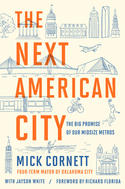Nearly three decades ago, journalist and educator Joel Garreau coined a new term, “Edge cities,” to describe the rise of commercial centers outside the downtowns (central business districts or CBDs) largely of the United States (Note 1). read more »
Newgeography.com - Economic, demographic, and political commentary about places
Why the Booster Club Won’t Save Minneapolis
Someone who took issue with my treatment of Minneapolis’ attraction issue sent me a link to this Star Tribune piece noting that migration into the region increased last year.
To be clear: this article is from March of this year, so I’m late to the game in analyzing it. But I don’t recall seeing it previously.
Here’s an excerpt: read more »
- Login to post comments
California Must Stop Trying To Stomp Out Suburbia
We may be celebrating — if that’s the right word — the tenth year since the onset of the financial crisis and collapse of the real estate market. Yet before breaking out the champagne, we should recognize that the hangover is not yet over, and that a new housing crisis could be right around the corner. read more »
- Login to post comments
Reconciling a Love for Trains with an Opposition to Subsidies
As a life-long railfan, I love passenger trains. But as a transportation economist, I hate subsidies for the way they dilute productivity and transfer wealth from the many to the few. Thus, I am a reluctant opponent of subsidies to Amtrak and urban rail transit.
Romance of the Rails, a new book that the Cato Institute will publish in October, is my attempt to reconcile these views by looking deep into the history of passenger rail transportation. read more »
- Login to post comments
More Work at Home than Take Transit, Transit Retreats into Niche Markets
The new American Community Survey data indicates at least two significant narratives with respect to work access trends (commuting and working at home). One is transit work is becoming even more concentrated in only six of the nation’s 20,000 municipalities, the six transit legacy cities. The second is that working at home has passed transit in access to jobs, it now trails only driving alone and car pools. read more »
- Login to post comments
Urban Divergence in Ohio
One trend we’ve seen in many domains is the bifurcation of society into two tiers, the successful and unsuccessful. One way we see this divergence playing out is between cities in the same state. This NBC article looks at divergence in Ohio between Dayton and Columbus. read more »
- Login to post comments
Welcome to Park Forest
Recently a follower sent me an interesting e-mail. He said he recently re-read The Organization Man by William Whyte, originally published in 1956. The suburban Chicago village of Park Forest, IL, about 30 miles directly south of the Loop, figured prominently in the book, as an example of the kind of Levittown-style suburban development that was taking America by storm at the time. In checking in about Park Forest today, he found that yesterday’s model of white middle class and middle management homogeneity is now a black-majority community. read more »
The Value of All Things Crazily Rich and Asian
Neither Kevin Kwan’s novel “Crazy Rich Asians” nor the movie based on it should win any prizes as literature or film. Yet the “Crazy” phenomena — both the best-selling book, its sequels and the smash movie — represent a critical moment not only in Asian, and Asian-American, history, but in how we look at race. read more »
- Login to post comments
Ten Years After Lehman Collapsed, We’re Still Screwed
The collapse of Lehman Brothers 10 years ago today began the financial crisis that crippled and even killed for some the American dream as we had known it. Donald Trump might be starting to change that, at least for Americans who aren’t determined to remain in our bluest and priciest cities. read more »
- Login to post comments
“Middle America” in America’s Urban Century
In the late 1990s and the early Aughts, when the last Gen Xers and the first Millennials were launching into their adult lives, “Urban America” was a very different place. On many fronts, the choices young ambitious graduates had were fast becoming limitless, save on one key front: the cities where they could reasonably want to live. read more »
- Login to post comments





















